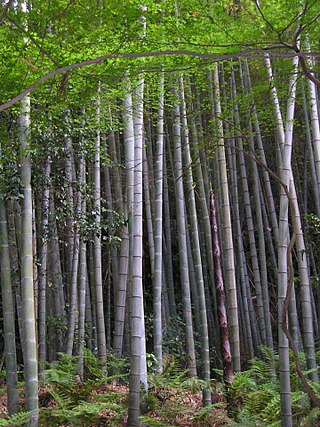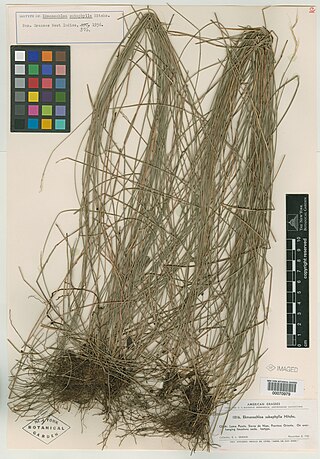
The Poales are a large order of flowering plants in the monocotyledons, and includes families of plants such as the grasses, bromeliads, rushes and sedges. Sixteen plant families are currently recognized by botanists to be part of Poales.

Bamboos are a diverse group of mostly evergreen perennial flowering plants making up the subfamily Bambusoideae of the grass family Poaceae. Giant bamboos are the largest members of the grass family, in the case of Dendrocalamus sinicus having individual stalks (culms) reaching a length of 46 meters, up to 36 centimeters in thickness and a weight of up to 450 kilograms. The internodes of bamboos can also be of great length. Kinabaluchloa wrayi has internodes up to 2.5 meters in length. and Arthrostylidium schomburgkii has internodes up to 5 meters in length, exceeded in length only by papyrus. By contrast, the stalks of the tiny bamboo Raddiella vanessiae of the savannas of French Guiana measure only 10–20 millimeters in length by about two millimeters in width. The origin of the word "bamboo" is uncertain, but it probably comes from the Dutch or Portuguese language, which originally borrowed it from Malay or Kannada.

Plantations are farms specializing in cash crops, usually mainly planting a single crop, with perhaps ancillary areas for vegetables for eating and so on. Plantations, centered on a plantation house, grow crops including cotton, cannabis, coffee, tea, cocoa, sugar cane, opium, sisal, oil seeds, oil palms, fruits, rubber trees and forest trees. Protectionist policies and natural comparative advantage have sometimes contributed to determining where plantations are located.

Dendrocalamus is a tropical Asian genus of giant clumping bamboos in the grass family. It is found in the Indian subcontinent, China, and Southeast Asia.

Dracaena sanderiana is a species of flowering plant in the family Asparagaceae, native to Central Africa. It was named after the German–English gardener Henry Frederick Conrad Sander (1847–1920). The plant is commonly marketed as "lucky bamboo"; this term has become one of its common names.
Monocarpic plants are those that flower and set seeds only once, and then die.

Dieffenbachia seguine, widely known as dumbcane, as well as leopard lily or tuftroot, is a species of Dieffenbachia, a flowering aroid plant of the family Araceae. It is native to the neotropical realm of the Americas, from extreme southern Mexico and Belize and much of Central America, as well as the northern half of South America. It is found on many Caribbean islands and territories, including Cuba, Grand Bahama, Grenada, Guadeloupe, Hispaniola, Îles des Saintes, Jamaica, Martinique, Puerto Rico, Saba, Saint Kitts and Trinidad and Tobago. D. seguine is also found on the Galápagos islands of Santa Cruz and San Cristóbal, where it was likely introduced by humans.

Chrysalidocarpus lutescens, also known by its synonym Dypsis lutescens and as golden cane palm, areca palm, yellow palm, butterfly palm, or bamboo palm, is a species of flowering plant in the family Arecaceae, native to Madagascar and naturalized in the Andaman Islands, Thailand, Vietnam, Réunion, El Salvador, Cuba, Puerto Rico, the Canary Islands, southern Florida, Haiti, the Dominican Republic, Jamaica, the Leeward Islands and the Leeward Antilles. Its native names are rehazo and lafahazo.

Bambusa vulgaris, common bamboo, is an open-clump type bamboo species. It is native to Bangladesh, India, Sri Lanka, Southeast Asia, and to the province of Yunnan in southern China, but it has been widely cultivated in many other places and has become naturalized in several regions. Among bamboo species, it is one of the largest and most easily recognized.

A bamboo fly rod or a split cane rod is a fly fishing rod that is made from bamboo. The British generally use the term "split cane." In the U.S., most use the term "bamboo." The "heyday" of bamboo fly rod production and use was an approximately 75-year period from the 1870s to the 1950s when fiberglass became the predominant material for fly rods. Nevertheless, bamboo fly rods made from skilled makers continue to be 'state-of-the-art' in performance and are cherished and revered by their owners.

The plushcap is a species of bird in the tanager family Thraupidae and it is the only member of the genus Catamblyrhynchus.

[[Image:|thumb|]] Cienfuegos Province Botanical Garden, officially, Jardín Botánico de Cienfuegos, also known as Jardín Botánico Soledad, is located 14 kilometres (8.7 mi) from Cienfuegos city centre.

Bamboo textile is any cloth, yarn or clothing made from bamboo fibres. While bamboo was historically used only for structural elements, such as bustles and the ribs of corsets, in recent years various technologies have been developed that allow bamboo fibre to be used for a wide range of textile and fashion applications.

Dendrocalamus strictus is a bamboo species belonging to the Dendrocalamus genus. The culms (stems) are often solid. Common names include male bamboo, solid bamboo, and Calcutta bamboo.

Ekmanochloa is a genus of plants in the grass family endemic to Cuba.
Mniochloa is a genus of Cuban plants in the grass family. The only known species is Mniochloa pulchella, native to eastern Cuba near Guantánamo.

Smilax laurifolia is a species of flowering plant in the greenbrier family known by the common names laurel greenbrier, laurelleaf greenbrier, bamboo vine, and blaspheme vine. It is native to the southeastern United States, where it occurs along the Gulf and Atlantic coastal plains from Texas to New Jersey, the range extending inland to Arkansas, Oklahoma, and Tennessee. It also occurs in Cuba and the Bahamas.

Bambusa polymorpha, or Burmese bamboo, is a species of clumping bamboo native to Bangladesh, China, Laos, Myanmar, Thailand, India, Sri Lanka, Java, and has been naturalized in Cuba, Puerto Rico, and Ecuador.
Arthrostylidium urbanii is a species of Arthrostylidium bamboo in the grass family.
Ximena Londoño de la Pava is a Colombian botanist, specializing in agrostology. She has done extensive research on the bamboo genus Guadua in South America and Central America.















